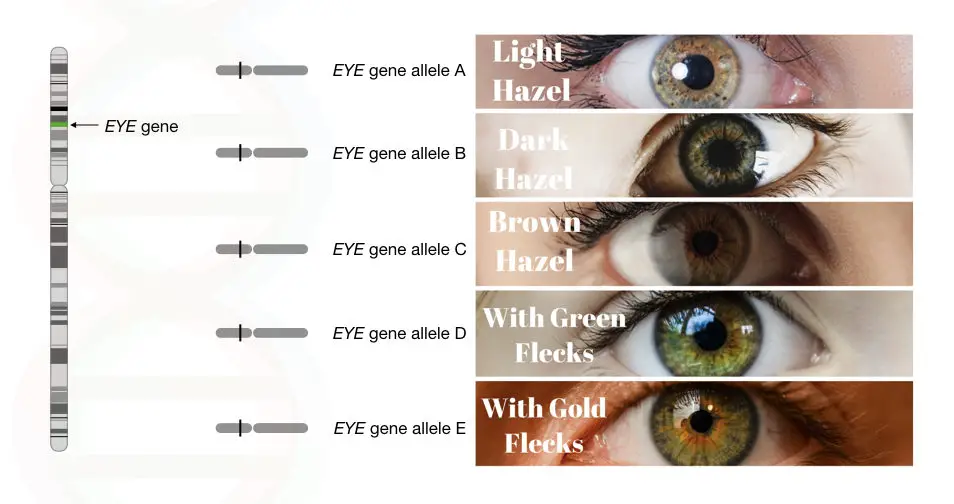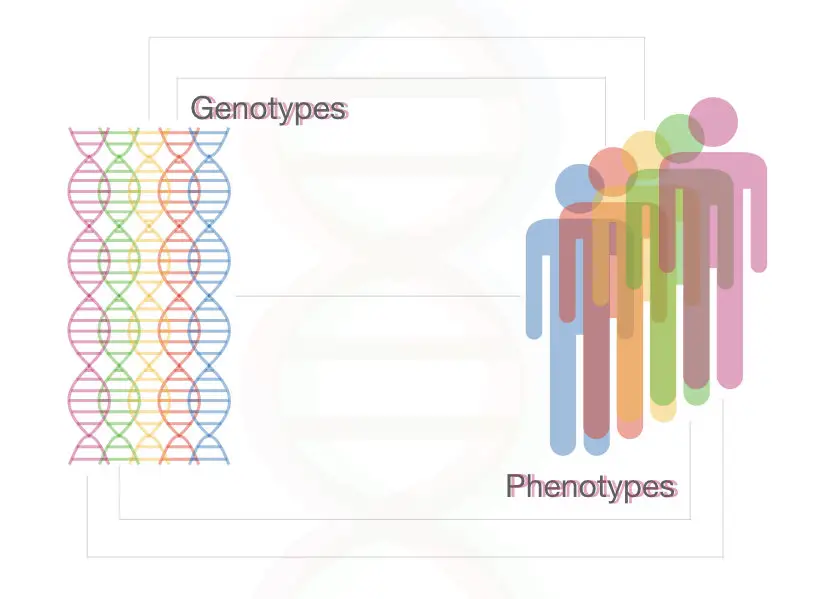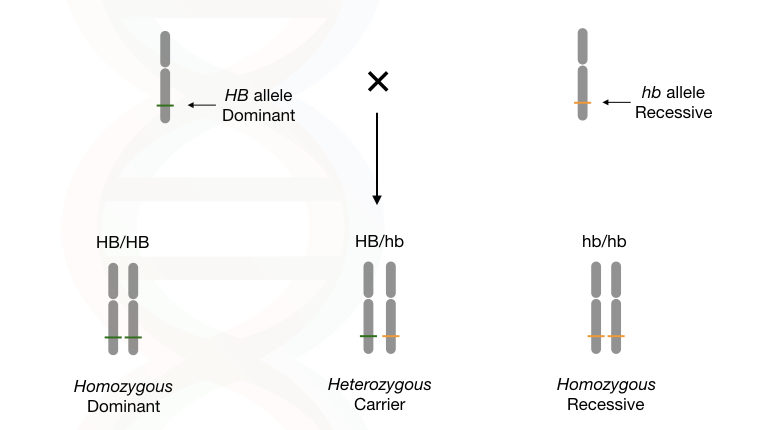“A field of science dealing with the study of DNA, genes, chromosomes and related alterations is known as genetics.”
In modern-day science, genetic studies comprise not only the study of DNA, genes and chromosomes but also protein-DNA interaction and other metabolic pathways associated with it.
In the present article, we are briefly introducing the genetics and common terminologies used. This article is only for beginners who are new to genetics.
The field of genetics was enlightened when Gregor Johann Mendel discovered the law of inheritance and the law of independent assortment during the years 1856-1863.
DNA, genes, and chromosomes are the major study focus in genetics. The DNA is a long chain, (more appropriately called the polynucleotide chain) of the nitrogenous bases having all the information of life.
DNA is a nucleic acid made up of deoxyribose sugar, phosphate and nitrogenous bases.
Two types of nitrogenous bases named purine and pyrimidines are present in the DNA. Adenine and Guanine are the purines while the Thymine and Cytosine are pyrimidines bases present in DNA.
Three hydrogen bonds between cytosine and guanine while two hydrogen bonds between thymine and adenine join two single-stranded DNA.
For more detail on DNA please read our article: DNA story: The structure and function of DNA
“A functional piece of DNA is called a gene.”
Key Topics:
Gene:
The gene is a coding DNA sequence that encodes a specific protein. Genes are the functional portion of our genome, approximately 3% of our genome encodes proteins.
The gene is made up of the exonic and intronic regions in which the intronic regions are spliced out from the final gene product.
“Alternative forms of a gene are referred to as alleles.”
To understand this, let’s take an example, Suppose one gene encodes for the eye color, let say it is EYE1, thus different eye colors can be produced by alteration in this gene. Variations in the EYE1 gene (alleles) produce various eye color shades, take a look at the figure below,

Read more: Gene.
The genes are located on chromosomes.
Chromosomes:
The chromosome is a complex network of DNA and proteins and an inheritance unit. Different organisms have different numbers of chromosomes.
23 pairs of chromosomes are present in humans of which 22 pairs of chromosomes are called autosomal chromosomes and one X and Y chromosome are called the sex chromosomes.
All the haploid set of our DNA is called a genome.
Read more: Chromosome.
Genome:
All the DNA in a haploid set comprises the coding as well as the non-coding DNA sequences is a genome.
Transposons, intervening sequences and introns are some of the non-coding DNAs of our genome. Though the non-coding DNA of us can not encode any proteins, it is involved in the regulation of gene expression.
Polymorphism or change in the non-coding DNA sequences of our genome which regulates the gene expression is called epigenetic alterations.
Read more: Genome.
The process of “central dogma” is one of the important processes that must be performed by a cell. Replication, transcription, and translation are collectively called a central dogma process.
The central dogma process is governed by the enzymatic catalytic reaction in which different enzymes such as DNA polymerase, primase, helicase, topoisomerase, RNA polymerase, ligase and other enzymes govern each step by its specific effects.
DNA polymerase: using the 3’ OH end, the DNA polymerase synthesizes a new DNA strand during replication (Read more: DNA polymerase).
RNA polymerase: RNA polymerase synthesizes an RNA strand during the process of transcription. It’s a de novo catalytic synthesis reaction.
Primase: primase synthesizes a short stretch of DNA or RNA. Primer is 12 to 22nts long and involved in the process of replications. (Read more: Primase).
Helicase: helicase unwinds double-stranded DNA for initiating replication (Read more: Helicase).
Topoisomerase: topoisomerase is a special class of enzyme that releases the tension on the remaining dsDNA strand during replication (Read more: Topoisomerase).
Ligase: it is an enzyme that fills the gap between the nucleotides by creating the phosphodiester bonds between them (Read more: Helicase).
Read our article on DNA replication: The general process of DNA replication.
The central dogma…
Replication:
Replication is an enzyme-dependent process in which the double-stranded DNA molecules synthesize four new single-stranded DNA. In short, it is a process of doubling or copying DNA.
Transcription:
Transcription is a process in which the mRNA is formed from the DNA having all the information for encoding a protein.
Translation:
The translation is a process in which the long chain of amino acids is formed from the mRNA. Three nucleotides create a codon and each codon encodes one particular amino acid. A long chain of amino acids builds a protein.
Different types of structural and functional proteins are formed from the balanced processing of central dogma. Imbalance in any step of replication, transcription or translation results in the disease condition.
Any alteration in the DNA sequence is known as mutation which can be either helpful or harmful. Read more on different types of mutations: Different Types Of Genetic Mutations.
However, in the majority of cases, it is harmful and causes some inherited or non-inherited disease conditions.

Genotype vs Phenotype:
A heritable genetic portion of a genome that is responsible for a particular phenotype or trait is called a genotype.
Whereas,
The observable traits of an organism originated due to the interaction between genotype or gene and the environment is called a phenotype.
The genotype is a genetic entity of a particular trait while the phenotype is a visible or observable entity of a particular trait.

Mitosis vs Meiosis:
Mitosis is a process of somatic cell division in which two daughter cells are formed with the same number of chromosomes.
On the contrary, meiosis occurs in the germline cells in which a new cell is generated from the parent cell having half or a haploid number of chromosomes.
Thus autosomal cells (all cells of our body, except the germ cells) have the exact 46 number of chromosomes while the germ cells have only haploid- 23 number of chromosomes.
A new organism originated from the fusion of sperm and egg cells (germ cells), here male and female contribute each set of haploid chromosomes. The resulting embryo has 46 chromosomes.
As the chromosomes are inherited, the genes located on the chromosomes are also inherited from parents to their offspring. In nature, the recombination process offers new variations/genotype/phenotype.
The exchange between the genetic material of two identical homologous chromosomes is called recombination.
Recombination occurs during the meiosis thus a new variation is inherited directly to the embryo and to the offspring.
Related article: Introduction To Genetics: Definition, History, Applications And Branches
Homozygous vs Heterozygous:
The condition in which an individual carries the same type of alleles is called a Homozygous condition. If it has two identical dominant alleles it is known as homozygous dominant or if it has two identical recessive alleles, it is known as homozygous recessive.
The condition in which an individual carries two different types of alleles, one dominant and one recessive, the condition is called heterozygous.
For example,
In one of the autosomal recessive blood disorders, called thalassemia, is an autosomal recessive condition. Here the presence of two recessive HB alleles causes the disease conditions.
The homozygous dominant condition is totally normal and does not show any sign of disease while the homozygous recessive condition is responsible for the occurrence of disease.
However, in the heterozygous condition, the individual does not show any sign of the disease but it can inherit the disease allele to the next generation hence the condition is often known as carrier condition.

Some organelles like mitochondria and chloroplast have their own DNA and own replication and transcription machinery.
However, the DNA of it is not arranged on chromosomes, instead, it has a circular arrangement and is located within the organelle. Note that some linear DNAs are also present in some organelles.
Read more: Organelle DNA.
“The process of replication and transcription occurs in the nucleus of a cell, once mRNA is transcribed, it is exported to the cytoplasm, at the ribosome, where the protein is synthesized.”
What are genetic disorders?
Genetic disorders are originated due to genetic mutations, chromosomal aberrations or epigenetic alterations.
Genetic disorders that occur by birth and are inherited to consecutive generations are called inherited genetic diseases are of different types:
Single-gene disorders Vs Multi-gene disorders:
Genetic disorders are originated due to mutation or a group of mutations in a single or group of genes.
If the disease occurs due to the mutation or mutations in a single gene. It is called a single-gene disorder, for example, sickle cell anemia.
If the disease occurs due to the mutations in more than one gene, it is called a multigenic disorder. For example, Diabetes or heart disease. These disorders are also called polygenic disorders.

Autosomal dominant vs Autosomal recessive:
Autosomal dominant disorders:
In the autosomal dominant condition, a single copy of a mutant allele is necessary to cause disease. The offspring have a 50% chance of having the disease.
Eg. Huntington’s disease.
Autosomal recessive disorders:
In the autosomal recessive condition, two copies of the mutant allele are required to cause disease in the offspring. The heterozygotic condition is called a carrier of the disease while the progenies have 25% of carrying the disease. Sickle cell anemia and thalassemia are classical examples of autosomal recessive disorders.
X-linked dominant vs X-linked recessive disorders:
In X-linked dominant conditions, only a single copy of the mutant (X inked) allele is required to cause a disease thus all the male individuals, as well as the female individuals of the progeny, carry the disease allele.
For example, fragile X syndrome.
In autosomal recessive conditions, two mutant (X linked) alleles are required to cause disease, again all the male individuals of the offspring carry the mutant gene and suffer from the disease while the female individuals remain in the carrier state if only a single mutant allele is present.
For example, Duchenne muscular dystrophy.
In another type of genetic disease, the disease originated due to the mutations in a gene or chromosome, which occurs after birth or under the influence of some environmental conditions.
For example cancer.
Cancer originates due to the interaction of genetic and environmental factors. For more detail read our article on cancer genetics: A Brief Introduction To Cancer Genetics.
Chromosomal aberrations:
The genetic disease originated due to the structural or numerical abnormalities of the chromosome called chromosomal aberrations.
Down syndrome is a numerical chromosomal abnormality in which one extra 21st number of chromosomes is responsible for some mental retardation.
Contrary, the Philadelphia chromosome is a structural chromosomal abnormality in which translocation between the chromosomes 14 and 22, q arm results in chronic myeloid leukaemia.
Read more: Philadelphia Chromosome, BCR-ABL1 Gene Fusion And Chronic Myeloid Leukaemia.
Polymerase chain reaction, DNA sequencing, DNA microarray, Genome-wide association studies, Karyotyping and Cytogenetics are some of the tools and techniques used in the identification of a single gene as well as multigenic disorders and chromosomal abnormalities.
Gene test or DNA test:
A Gene test or DNA test is used to identify mutations at a molecular level associated with the genetic disease
Polymerase chain reaction, DNA sequencing and DNA microarray are the techniques used to find out the mutations associated with genetic disease.
Read more on related tools:
Chromosomal test:
The chromosomal test is conducted to screen or find out the chromosomal aberrations associated with the genetic disorder.
FISH and Karyotyping are the traditional and popular cytogenetic methods used for screening chromosomal aberrations.
Read more on the related tool: A Karyotyping Protocol For Peripheral Blood Lymphocyte Culture
Biochemical test:
The biochemical test is performed to find out the protein abnormality associated with the gene and associated genetic disease.
ELISA like enzymatic assays is generally used for screening these types of abnormalities.
In recent days science, genetic tools and techniques are used in almost all branches of science for varieties of applications.
The genetic techniques are used in zoology, plant biology, animal breeding studies, forensic science, anthropology, medicines and human disease studies.
We have covered an amazing article on genetics which includes all the information of different branches of genetics and its applications. Read the article here: Introduction To Genetics: Definition, History, Applications And Branches.
Conclusion:
Genetics is one of the most emerging branches of science and after the discovery of the structure of DNA by Watson and Crick in 1953, it became more and more popular.
Nowadays, gene therapies and gene editing technologies allow scientists to replace the mutant gene with new wild-type healthy genes. CRISPR-CAS9 and viral vector-mediated gene therapies are now ready for pre-clinical trials. Also, the shRNA and siRNA-like RNA interference techniques are now available for the gene expression and gene function assays.
In the near future, by using genetic tools and techniques we can prevent and eliminate any genetic disorders before birth.



Useful information about Genetics for all kind of Learners
Thank you